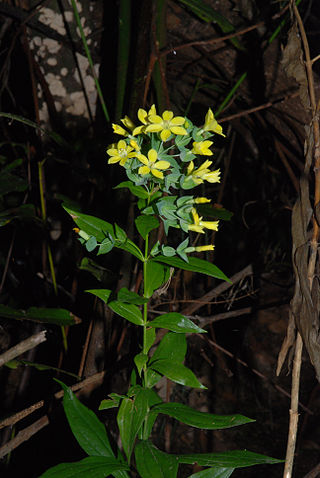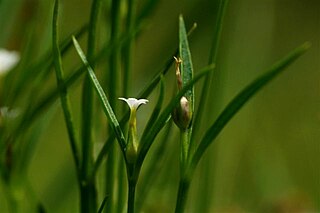
Gentianaceae is a family of flowering plants of 105 genera and about 1600 species.

Centaurium (centaury) is a genus of 20 species in the gentian family (Gentianaceae), tribe Chironieae, subtribe Chironiinae. The genus was named after the centaur Chiron, famed in Greek mythology for his skill in medicinal herbs. It is distributed across Europe and Asia.

The genus Macrocarpaea, with 105 species and two hybrids of 0.5 m herbs, shrubs, epiphytes and small trees to 10 m tall, is the largest genus of the tribe Helieae of the gentian family (Gentianaceae). Species of Macrocarpaea have diurnal and nocturnal pollinators, visited during the day by hummingbirds, insects and butterflies, and at night by bats, moths and many different kinds of insects. The common name for the genus is 'Moon-gentian'. No species are known in cultivation.

Schenkia sebaeoides, known as ʻĀwiwi in Hawaiian and lavaslope centaury in English, is a rare species of flowering plant. It is endemic to low shrublands in the state of Hawaiʻi in the United States. It is present on the islands of Kauai, Oahu, Lanai, Molokai, and Maui. At the time it was added to the endangered species list of the United States in 1991 it was known from seven populations for a total of fewer than 1000 individuals. It is threatened by habitat loss.

Exacum is a genus of plant in family Gentianaceae. It contains 75 species native to tropical regions of sub-Saharan Africa, southern Arabian Peninsula, south and southeast Asia, New Guinea, and Australia.

Ixanthus is a monotypic plant genus in the family Gentianaceae. The sole species, Ixanthus viscosus, is endemic to Canary Islands laurel fields and displays small yellow flowers when in bloom.

Sebaea is a genus of annual plants in the family Gentianaceae. Species occur in Africa, Madagascar, India, China, Thailand, Australia and New Zealand. The genus was paraphyletic and has been split in four genera: Exochaenium, Klackenbergia, Lagenias and Sebaeas.str.. Synapomorphies for Sebaea s.str. include the presence of extra stigma along the style and the shape of the testa cells of the seeds.

Genianthus is a genus of plants in the family Apocynaceae, first described as a genus in 1883. It is native to southern China, the Indian Subcontinent, and Southeast Asia.
Calyptranthera is a genus of plants in the family Apocynaceae, first described as a genus in 1996. The entire genus is endemic to Madagascar in the Indian Ocean.

The genus Exochaenium is endemic to sub-Saharan Africa, with species occurring in most tropical and sub-tropical regions of the continent, particularly on the Katanga plateau, with many extending to the Sudano-Zambesian and Guineo-Congolian regions. The genus is monophyletic and is used to study the variation and evolution of herkogamy.

Klackenbergia is a genus of flowering plants belonging to the gentian family (Gentianaceae) and the tribe Exaceae. It only contains two species, both endemic to Madagascar. They are notable for their inflorescence with characteristic long bracts and bracteoles and sub-sessile flowers arranged in axillary fascicules at each node.

Exaceae is a flowering plant tribe in the family Gentianaceae. Exaceae comprises about 180 species assigned to eight monophyletic genera, with major centres of endemism in continental Africa, Madagascar and the southern tip of India and Sri Lanka (14 endemic species).
Ornichia is a plant genus in the gentian family (Gentianaceae), tribe Exaceae. The genus is endemic to Madagascar.
Gentianothamnus is a monotypic plant genus in the gentian family (Gentianaceae), tribe Exaceae. The sole species is Gentianothamnus madagascariensis. It is endemic to Madagascar.

Symbolanthus, the ring‐gentians, are a genus of flowering plants in the family Gentianaceae, native to the montane tropics of southern Central America and northern and eastern South America.
Gyrandra is a genus of flowering plants in the family Gentianaceae, found in Texas, Mexico and Central America. Annual herbs, they are usually found in montane pine-oak forests.
Zonanthus is a genus of flowering plants belonging to the family Gentianaceae.
Xestaea is a genus of flowering plants belonging to the family Gentianaceae.
Bisgoeppertia is a genus of flowering plants belonging to the family Gentianaceae.

Camptocarpus semihastatus is a species of plant in the Apocynaceae family. It is native to Madagascar. Jens Klackenberg, the botanist who formally described the species named it after the distinct coronal lobes of its flowers that resemble half the head of a spear.












